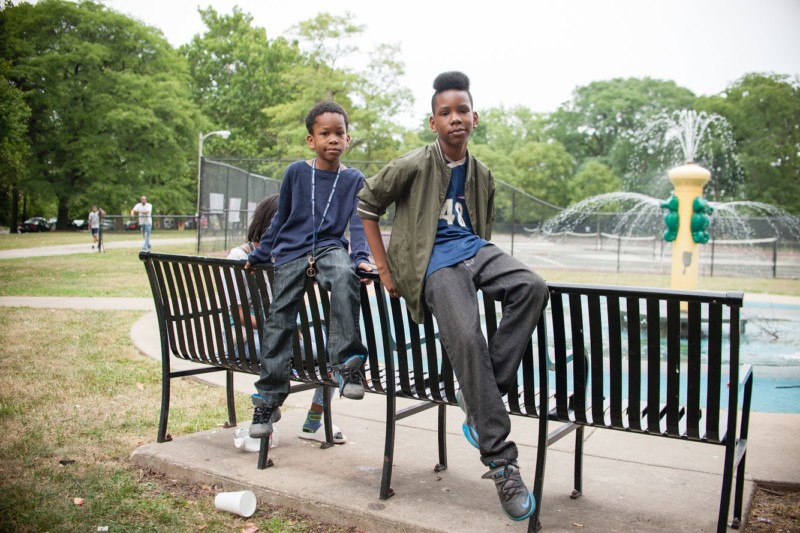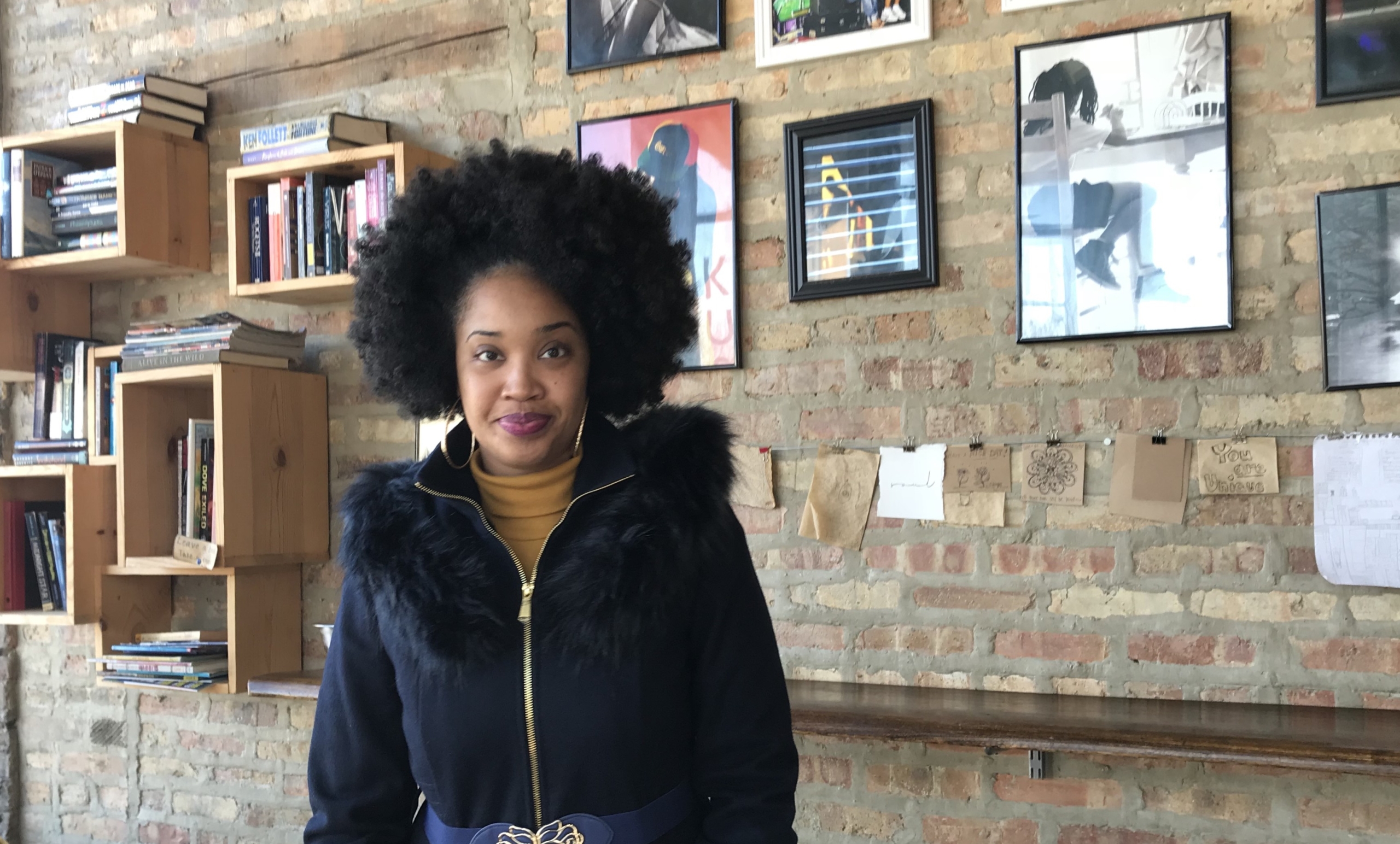Sign up for the daily CJR newsletter.
WHEN TONIKA JOHNSON walks into the Kusanya Cafe in Englewood, it is as if she inhabits a scene from one of her photographs. Neighbors drink from coffee mugs, and there’s small talk at the metal counter. The cafe’s fogged and frosted windows restrict the view from the snow-covered sidewalk.
Englewood, which consistently has been named one of Chicago’s highest-crime neighborhoods, is often shrouded, too. Even as the number of shootings in Englewood plummeted this year, the neighborhood can seem stuck in an endless loop of news stories about gang warfare and gun violence and school closings.
RELATED: Suburban Chicago news company vies for recognition in unfamiliar terrain
Through each news cycle, Johnson—a street photographer and community activist who grew up here on the city’s southwest side—has documented Englewood’s subtle moments of beauty and joy. Among Johnson’s images, a viewer encounters a father at a park swing with his baby, a mother and daughter on a stoop, a woman at a laundromat fixing a child’s hair.
“For people who are from Englewood or a neighborhood like it, it’s the story of here,” Johnson says of her photographs. “It’s an artistic photo album.”

Two brothers at So Fresh Saturdays, a free public, family-oriented summer festival that reclaims local parks in Greater Englewood to promote peace, hosted by Resident Association of Greater Englewood. Photo by Tonika Johnson.
In December, Chicago Magazine named Johnson one of its “Chicagoans of the Year”—an honor she shares with scientists who created a treatment for river blindness and the more than 300 lawyers who helped passengers at O’Hare International Airport after Donald Trump’s travel ban, among others. The magazine billed Johnson, who is 38, as “Englewood’s Everyday Archivist.” At the cafe, Johnson is gently ribbed for being a “media darling.”
“I’m not used it,” Johnson says with a laugh. “It’s forcing me to think about my art in a way I hadn’t thought of it before. I didn’t fully accept responsibility of the larger context. I was just taking pictures.”
Since she began photographing her neighborhood in 2006, Johnson’s reputation has mostly been confined to the community. That changed this year. Johnson’s work was featured on giant billboards in Englewood as part of a campaign to rebrand the neighborhood from the inside out. And—in a protest against Trump’s campaign rhetoric about Chicago violence—she has recently tried to get her images in front of a larger audience, outsiders who don’t know Englewood with the intimacy of a lifelong resident raising her two teenagers in the same neighborhood. In 2017, Johnson exhibited her work at Rootwork Gallery, the Chicago Cultural Center, and Harold Washington Library.
“To me, much of the power of her work comes from its authenticity,” says Mick Dumke, a reporter for ProPublica Illinois who has known Johnson since she was a photography intern at the Chicago Reporter. “While so many narratives about Englewood and Auburn-Gresham are centered on decay, Toni’s images are full of the colors and poetry of everyday existence. Photo by photo, she challenges preconceptions—not by shouting at us to open our eyes, but by showing us what we would see if we did.”
The Chicago Reader featured her pictures in an August cover story about life beyond the headlines in Englewood. In one of the images, a woman is captured in a solitary moment, walking down a wide street. Johnson snapped the photo from an abandoned elevated rail line. In another, a 24-year-old smiles into the camera as her yellow curls consume the frame.
“Tonika provided a beautiful story for the Reader,” says Jamie Ramsay, the alt-weekly’s photo director. Johnson’s work, says Ramsay, was “uplifting and well-executed.”
Photographers, says Johnson, ‘no longer have the privilege to stay in a neighborhood to get to know it.’
JOHNSON SAYS HER WORK is inspired by early mentors in photojournalism, John H. White and Ovie Carter, two black photographers whose Pulitzer Prize–winning work helped shape and define photojournalism in the city. Carter, whom Johnson met when she was a high school student, encouraged her to pursue a journalism degree, which she did at Columbia College Chicago. She also studied photography while at Columbia College, where White teaches. Of her mentors, Johnson says she was amazed at how they “captured the neighborhood that was so familiar to me with such dignity, photographic precision and truth without exploiting the obvious inequities.”
While in college, during her photography internship at the Reporter, Johnson met Dumke and some of the city’s great reporters, including Sarah Karp and Laura Washington. She watched them tackle big reporting projects with a passion and zeal that intimidated her. On one of her first assignments with Dumke, to interview inmates at the county jail, Dumke had to remind Johnson to take pictures, she recalls.
She brings the lens of an insider, someone who isn’t just looking at Englewood because of its national reputation…who isn’t there just to extract the value of shocking photographs to sell to an exploitative, voyeuristic public.”
Johnson spent 10 weeks in 2017 as a photojournalism fellow at Chicago’s City Bureau, a nonprofit civic journalism lab on the city’s south side. During her fellowship, Johnson worked on a project that maps the city’s racial segregation through images. The project, “Folded Map,” is still in progress, though there are plans to exhibit Johnson’s work at the Loyola University Museum of Art this fall. Johnson detailed “Folded Map” in a Medium post in late December:
My idea was to choose homes on opposite sides of the city (6100 S. Wolcott and 6100 N. Wolcott, for instance) and document their differences through photography. …By the time my fellowship ended, my project wasn’t complete but City Bureau helped me develop it into a powerful visual investigation of geography, territory, its relationships to the people who inhabit these neighborhoods and the historical economic forces that have shaped them.
“Her photographs are compelling because she brings the lens of an insider, someone who isn’t just looking at Englewood because of its national reputation…who isn’t there just to extract the value of shocking photographs to sell to an exploitative, voyeuristic public,” says City Bureau co-founder Bettina Chang. “She is examining and pulling apart the layers of life in a place that she calls her own.”
The images she captures aren’t sanitized, Chang says of Johnson’s work. “She doesn’t turn away from the signs of poverty and other misfortune in Englewood, but she also isn’t solely looking for those types of photographs.”
I’m just hoping people will see her work and understand more than what people are saying about Englewood.
JOHNSON IS ALSO PROGRAM MANAGER of the Resident Association of Greater Englewood, which she co-founded in 2010. She says the city’s news photographers used to spend time in neighborhoods like hers. But as newsrooms have downsized, and with fewer photographers left on staff at the major news outlets, photographers only seem to show up when something bad happens or if they have a project to document, which usually centers on crime or violence.
“They no longer have the privilege to stay in a neighborhood to get to know it,” says Johnson.
The Chicago Sun-Times eliminated its photography staff in 2013. Rich Hein, the Sun-Times’ photo editor, acknowledges the coverage gap such reductions can create.
“The only time I will assign someone is when the news desks comes up with an angle,” he says. “Generally we would only go when somebody was killed or if there was a police shooting or a policeman was shot. Unfortunately, without a photo staff, that is what we are going to cover.”
Too many images of black America depict it as “deficit-ridden,” says Tracie Hall, founder and owner of Rootwork Gallery, which exhibited Johnson’s work in 2017. Hall says Johnson’s images capture a part of black American life that can be invisible to outsiders.
“I’m just hoping people will see her work and understand more than what people are saying about Englewood,” Hall says about Johnson. “This photographer is actually capturing that world and showing it to be full of radiance and beautiful people.”
RELATED: Chicago reporters on covering the city’s violence during the Trump era
Has America ever needed a media defender more than now? Help us by joining CJR today.







